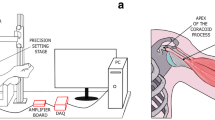Summary
In the present study, 24 patients suffering pain from a phantom limb were given vibratory stimulation or placebo as a pain-relieving measure. During stimulation, a reduction in pain was reported by 75% of the patients as compared to 44% during placebo. Depending on the phantom sensation, the best pain-reducing site was found to be either the area of pain or the antagonistic muscle. In 90% of the patients the best pain-reducing effect was obtained when stimulation was applied with moderate pressure over a large area. The results of the present study suggest that vibratory stimulation may be a valuable symptomatic treatment measure in patients suffering pain from a phantom limb.
Similar content being viewed by others
References
Abramson AS, Feibel A (1981) The phantom phenomenon, its use and disuse. Bull NY Acad Med 57:99–112
Andersson SA, Holmgren E, Ross A (1977) Analgesic effects of peripheral conditioning stimulation. III. Effect of high frequency stimulation, segmental mechanisms interacting with pain. Acupunct Electro-Ther Res 2:237–246
Barbut D, Polak JM, Wall PD (1981) Substance P in spinal cord dorsal horn decreases following peripheral nerve injury. Brain Res 205:289–298
Brown WA (1968) Postamputation phantom limb. Dis Nerv Syst 299:301–306
Carlen PC, Wall PD, Nadvorna H, Steinbach T (1978) Phantom limbs and related phenomena in recent traumatic amputations. Neurology (Minneap) 28:211–217
Chang Hsian-Tung (1978) Neurophysiological basis of acupuncture analgesia. Sci Sin 21:829–846
Devor M, Claman D (1980) Mapping and plasticity of acid phosphatase afferents in the rat dorsal horn. Brain Res 190:17–28
Dostrovsky JO, Millar J, Wall PD (1976) The immediate shift of afferent drive of dorsal column nuclear cells following deafferentation: a comparison of acute and chronic deafferentation in gracile nucleus and spinal cord. Exp Neurol 52:480–495
Eriksson M, Sjölund B (1976) Acupuncturelike electroanalgesia in TNS-resistent chronic pain. In: Zotterman Y (ed) Sensory functions of the skin. Pergamon Press, Oxford New York, pp 575–580
Handwerker MO, Iggo A, Zimmerman M (1975) Segmental and supraspinal actions on dorsal horn neurons responding to noxious and non-noxious skin stimuli. Pain 1:147–165
Horch KW, Lisney SJW (1981) Changes is primary afferent depolarization of sensory neurons during peripheral nerve regeneration in the cat. J Physiol (Lond) 313:287–299
Hunt SP, Rossop MN, Emson PC, Clement-Jones V (1982) Substance P and enkephalins in spinal cord after limb amputation. Lancet I:1023
Jensen TS, Krebs B, Nielsen J, Rasmussen P (1983) Phantom limb, phantom pain and stump pain in amputees during the first 6 months following limb amputation. Pain 17:243–256
Lundeberg T (1984) The pain suppressive effect of vibratory stimulation and transcutaneous electrical nerve stimulation (TENS) as compared to aspirin. Brain Res 294:201–209
Lundeberg T (1983) Vibratory stimulation for the alleviation of chronic pain. Acta Physiol Scand [Suppl] 523:1–51
Lundeberg T (1985) Naloxone does not reverse the pain-reducing effect of vibratory stimulation. Acta Anaesth Scand 29:212–216
Melzack R (1971) Phantom limb pain. Implications for treatment of pathological pain. Anesthesiology 35:409–419
Noordenbos W (1959) Pain. Elsevier, Amsterdam
Sherman RA, Sherman CJ, Gall NG (1980) A survey of current phantom limb pain treatment in the United States. Pain 8:85–99
Sjölund BH, Eriksson MBE (1979) The influence of naloxone on analgesia produced by peripheral conditioning stimulation. Brain Res 73:295–301
Sunderland S (1978) Nerves and nerve injuries. Churchill-Livingstone, Edinburgh
Wall PD (1981) On the origin of pain associated with amputation. In: Siegfried J, Zimmermann M (eds) Phantom and stump pain. Springer, Berlein Heidelberg New York, pp 2–14
Wall PD, Devor MO (1981) The effect of peripheral nerve injury on dorsal root potentials and on transmission of afferent signals into the spinal cord. Brain Res 209:95–111
Author information
Authors and Affiliations
Rights and permissions
About this article
Cite this article
Lundeberg, T. Relief of pain from a phantom limb by peripheral stimulation. J Neurol 232, 79–82 (1985). https://doi.org/10.1007/BF00313905
Received:
Accepted:
Issue Date:
DOI: https://doi.org/10.1007/BF00313905




